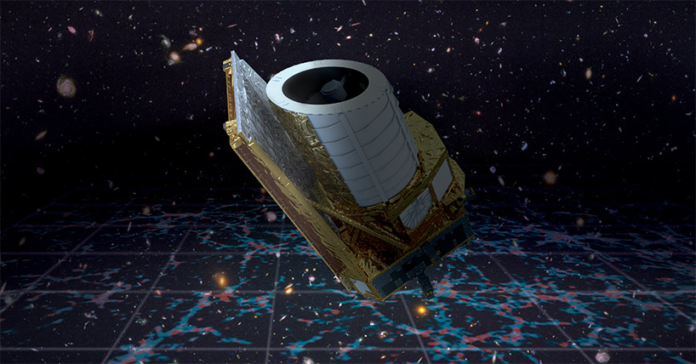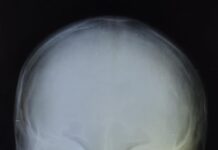The Euclid Dark Energy Satellite Mission has been successfully launched on a SpaceX Falcon 9 rocket and Newcastle University’s team is developing new methods to analyse its data
The European Space Agency’s (ESA) Euclid flagship Dark Energy Satellite Mission has launched from Cape Canaveral in Florida on a SpaceX Falcon 9 rocket.
Euclid’s 6-year mission is to map the dark Universe, using the positions of galaxies and images of dark matter produced from the gravitational lensing distortions of distant galaxies. The galaxy and dark matter maps contain information about the expansion history of the Universe and the growth of structure within it. By analysing these maps, astronomers will be able to determine the nature of both dark matter and dark energy. Dark matter, which unlike normal matter does not reflect or emit light, binds together galaxies creating the environment for stars, planets and life, while dark energy is the mysterious new phenomenon which is pushing galaxies away from each other and causing the expansion of the Universe to accelerate.
To achieve this, the Euclid Consortium team will carry out a very precise and accurate analysis of the images and distances of 1.5 billion galaxies over one-third of the sky. Gravitational lensing causes a one part in a hundred change in these galaxy images, which need to be measured from the sample to a precision of one part in a hundred thousand, presenting a major data-analysis challenge. Euclid will also measure the spectrum of light from over 35 million galaxies to accurately measure their distance from Earth.
To carry this out the Euclid satellite hosts two state-of-the-art instruments, an optical camera (VIS) built in the UK, and a Near-Infrared (NISP) camera led by France. The VIS Instrument will take images as sharp as those from the Hubble Space Telescope to measure the gravitational lensing distortions. The NISP Instrument will take multicolour images and the spectrum of light of galaxies from which their distance can be measured. Euclid’s wide field of view and large instruments will allow it to image more area of sky in one day than Hubble in its first 25 years.
ALSO READ: Tata Technologies launches InnoVent – an innovation platform for young engineering students
Answering the biggest questions about the Universe
After Launch Euclid will travel over 1 million miles into space away from the Sun, where the combined gravity of the Sun and Earth will cause it to orbit the Sun once a year, in step with the Earth. It will scan the sky and send many petabytes of data back to ESA’s ground stations. From there Euclid’s data is distributed across nine Euclid Science Data Centres, including the UK’s Science Data Centre in Edinburgh. The Data Centres will process the Euclid data, along with data from complementary ground-based astronomical surveys, day and night, ready for teams of scientists to work on, with the results released to the public.
To realise Euclid’s ambitious mission, more than 2000 scientists from Europe, including many from the UK, along with the European Space Agency and industrial teams, have assembled to design and build Euclid, and to analyse the data from it. The UK has been involved in the design and building of Euclid from its earliest days, co-leading the teams defining the science programme and observational strategy, leading the construction of the VIS Instrument, leading the gravitational lensing data analysis and production of its high-level data products, and coordinating the science analysis for Euclid, along with many other roles. Members of Newcastle University’s research groups for Cosmology and Observational Astronomy are involved in developing new methods for extracting the maximum information from Euclid’s unprecedented data, with the help of the NUdata STFC Centre for Doctoral Training in Data Intensive Science.
Revolutionising studies across all of astronomy
Dr Cora Uhlemann of Newcastle University, who co-leads the Additional Galaxy Clustering Probes work package in Euclid, said “This is an exciting time for cosmology and astronomy more broadly. Combining the exquisite Euclid data with theoretical models and numerical simulations will allow us to answer some of the biggest questions we have about the Universe and its future. It’s remarkable what the international collaboration of Euclid’s many scientists and engineers has achieved, and Euclid’s results could change our understanding of nature.’ The team at Newcastle University includes Dr Joachim Harnois-Déraps (STFC Ernest Rutherford Fellow) and Dr Lina Castiblanco Tolosa (STFC-funded Research Associate). Together they work on establishing novel statistics and methods to extract fundamental physics from Euclid’s data for galaxy clustering and weak gravitational lensing.
As well as aiming to answer some of science’s most fundamental questions about the nature of the Universe, Euclid is set to revolutionise studies across all of astronomy, providing a legacy database for professional astronomers and the public to explore.
Image description: Artist impression of the Euclid mission in space. The spacecraft is white and gold and consists of three main elements: a flat sunshield, a large cylinder where the light from space will enter, and a ‘boxy’ bottom containing the instruments. The spacecraft is shown half in the shadow, because the sunshield will always be faced in the direction of the Sun and thus protecting the telescope from the light of the Sun. The background is a realistic representation of a deep field view of the night sky, with many galaxies visible. On the bottom half of the image, an artistic representation of the cosmic web is overlayed over the galaxies. The cosmic web is the scaffolding of the cosmos on which galaxies are built, consisting primarily of dark matter and laced with gas. The cosmic web is here represented with a grid and a two-dimensional representation of a cosmological simulation.
Important Announcement – EasyShiksha has now started Online Internship Program “Ab India Sikhega Ghar Se”
Image description: A simulated high-resolution map of dark matter covering a size of 4 full moons (1 square degree). Image: Made by: Dr Joachim Harnois-Déraps.
Image description: The image by Dr Lina Castiblanco Tolosa illustates joint statistics of foreground galaxy counts and the weak lensing of background galaxy shapes by the dark matter in the foreground. Gravitational clustering causes a skewed distribution of matter in the Universe: most regions have densities below average (dashed line), while some regions feature concentracted structures with much higher densities than average.
ABOUT NEWCASTLE UNIVERSITY: Newcastle University, UK, is a thriving international community of more than 28,000 students from over 130 countries worldwide.As a member of the Russell Group of research-intensive universities in the UK, Newcastle has a world-class reputation for research excellence in the fields of medicine, science and engineering, social sciences and the humanities.Its academics are sharply focused on responding to the major challenges facing society today. Our research and teaching are world-leading in areas as diverse as health, culture, technology and the environment. Newcastle University is committed to providing our students with excellent, research-led teaching delivered by dedicated and passionate teachers. Newcastle University is ranked 110th in the QS World Ranking 2024 and 139th in the Times Higher Education World University Ranking 2023.
This year educate yourself and develop your career with EasyShiksha

































































